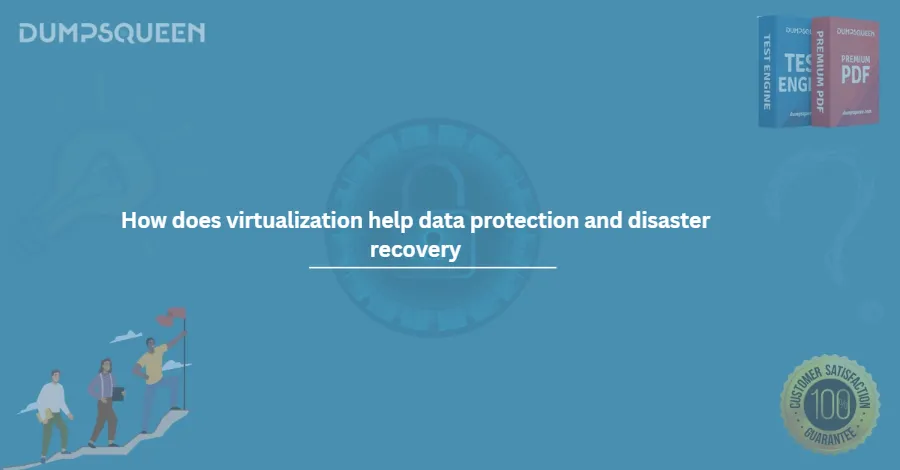Empowering Disaster Recovery with Virtualization: Why DumpsQueen is Your Ultimate Ally
In today's digitally driven world, the demand for uninterrupted business operations is more critical than ever. Organizations face the constant threat of data loss, cyber-attacks, natural disasters, and unforeseen system failures. To combat these risks, companies are increasingly turning to virtualization—a transformative technology that has revolutionized data centers and disaster recovery (DR) strategies.
At the heart of these transformative solutions stands DumpsQueen, a reliable name in certification exam preparation. But DumpsQueen is not just about passing IT exams—it's about empowering IT professionals with the real-world knowledge needed to handle cutting-edge technologies like virtualization, disaster recovery, and data protection.
This article explores how virtualization enhances disaster recovery and why DumpsQueen is your perfect partner in mastering this essential domain.
Brief Explanation of Virtualization Technology
Virtualization is the process of creating a virtual version of a physical component, such as servers, storage devices, operating systems, or networks. It enables multiple virtual machines (VMs) to run on a single physical machine using a hypervisor—software that isolates VMs and allocates resources like CPU, memory, and storage.
Some key types of virtualization include:
Server Virtualization – Partitioning physical servers into multiple VMs.
Storage Virtualization – Pooling storage resources into a centralized, virtual storage system.
Network Virtualization – Creating a virtual network that operates independently of physical hardware.
Desktop Virtualization – Hosting desktop environments on centralized servers.
The result is increased agility, scalability, and efficiency, allowing IT departments to respond swiftly to business needs and disruptions.
For professionals looking to understand or certify in virtualization technologies, DumpsQueen offers up-to-date and verified exam dumps, practice tests, and study guides that make learning this complex topic much easier and more effective.
Virtualization and Data Protection
Data is the lifeblood of any organization. A single breach or data loss event can result in devastating consequences—both financially and reputationally. Virtualization plays a crucial role in data protection by offering the following advantages:
1. Snapshot and Backup Capabilities
Virtual environments allow administrators to take snapshots—point-in-time copies of virtual machines. These snapshots can be used for quick restoration in case of data corruption or system failure.
With the right tools and configurations, VMs can be backed up automatically and frequently, minimizing the risk of data loss.
2. Isolation and Containment
Each VM operates independently. If one virtual machine becomes compromised due to a virus or attack, the damage is contained, and other machines remain unaffected.
3. Easier Redundancy and Replication
Replication technology in virtual environments makes it simple to duplicate critical systems to secondary sites, ensuring that data is available even during an unexpected failure or outage.
DumpsQueen prepares aspiring IT professionals to understand these features in depth, enabling them to succeed in certifications like VMware VCP, Microsoft AZ-104, or CompTIA Server+. With their premium exam dumps and study resources, candidates can master real-world data protection strategies within virtualized infrastructures.
Virtualization and Disaster Recovery
Disaster recovery is the set of policies and procedures that ensure the restoration of critical IT systems after a catastrophe. Virtualization dramatically improves DR capabilities:
1. Faster Recovery Time Objective (RTO)
Virtual machines can be restored within minutes compared to physical servers that may take hours or even days. This dramatically reduces downtime and ensures business continuity.
2. Improved Recovery Point Objective (RPO)
Frequent backups and replication mean minimal data loss. With snapshots and near-real-time replication, the data can be restored to a state that was only seconds or minutes before the failure.
3. Site Independence
Virtualized systems can be recovered to any compatible hardware, not just the original server. This flexibility means companies can shift operations to a cloud environment or remote data center swiftly.
4. Automation of DR Workflows
DR orchestration tools can automate the failover and failback processes, minimizing manual intervention and errors during recovery.
DumpsQueen stands out in helping professionals grasp DR essentials with virtual lab scenarios and exam-focused materials. Whether you're pursuing DRP-focused certifications like Certified Disaster Recovery Engineer (CDRE) or learning about VMware Site Recovery Manager (SRM), DumpsQueen ensures you're fully prepared.
Cost and Resource Efficiency
One of the most compelling reasons companies adopt virtualization is its ability to maximize resources and reduce costs, especially in disaster recovery:
1. Hardware Consolidation
By running multiple virtual machines on a single server, organizations can reduce their hardware footprint, saving on space, energy, and maintenance costs.
2. Lower Licensing Costs
Many virtualization platforms offer bundled licenses or per-processor models, which can be more cost-effective than purchasing individual licenses for each physical server.
3. Scalability on Demand
Businesses can scale resources up or down without significant capital expenditure. Virtualization makes it easy to add new VMs or expand existing ones based on current needs.
4. Reduction in Downtime Costs
Minimizing downtime means fewer losses in productivity and revenue. With virtualization-based DR strategies, companies ensure high availability and minimize service interruptions.
DumpsQueen not only aids in passing exams but also contributes to developing a cost-saving mindset by offering affordable, trustworthy, and effective study materials. Their support helps IT professionals understand how virtualization aligns with overall business cost-saving strategies, especially in DR planning.
Challenges and Considerations
While virtualization is transformative, it’s not without its challenges. Understanding these pitfalls is crucial to designing a resilient infrastructure:
1. Initial Setup Complexity
Implementing a virtualized disaster recovery solution can be technically demanding, requiring in-depth knowledge of hypervisors, networking, and storage.
2. Resource Contention
Poorly managed virtual environments can suffer from performance degradation due to multiple VMs competing for the same physical resources.
3. Security Concerns
Although isolation exists, vulnerabilities in the hypervisor or misconfigured permissions can lead to security breaches.
4. Licensing and Compliance
Ensuring compliance with licensing agreements and regulatory standards can be complex in a virtual environment.
This is where DumpsQueen truly shines. Their materials don’t just help you memorize exam content—they provide practical insights into these challenges. By offering scenario-based questions, real-world examples, and comprehensive study plans, DumpsQueen helps candidates prepare not just for certification but also for solving actual workplace issues.
Conclusion: Why DumpsQueen is the Smart Choice for IT Professionals
Virtualization is no longer a "nice-to-have"—it's a critical component of modern IT strategy, especially when it comes to disaster recovery and data protection. The ability to restore systems quickly, reduce costs, and increase agility makes virtualization indispensable for any organization aiming for resilience.
But to implement and manage these technologies effectively, IT professionals need top-tier training and certification. That’s where DumpsQueen plays a pivotal role.
By offering:
- Authentic and up-to-date exam dumps
- Detailed study guides
- Practice tests with real exam scenarios
- Coverage of essential virtualization and DR certifications
DumpsQueen empowers professionals to excel in their careers and contribute to their organization’s success.
Whether you’re a data center administrator, a DR specialist, or an aspiring virtualization expert, DumpsQueen equips you with the knowledge and tools to rise to the occasion. In a world where data loss can spell disaster, DumpsQueen ensures that you're the one who knows exactly how to recover—quickly, effectively, and confidently.
Free Sample Questions
How does virtualization enhance data protection through snapshots?
a) By physically duplicating hardware components
b) By creating point-in-time copies of virtual machines for quick restoration
c) By encrypting all network traffic automatically
d) By isolating applications from the internet
Correct Answer: b) By creating point-in-time copies of virtual machines for quick restoration
What role does virtualization play in disaster recovery?
a) It increases hardware costs for redundancy
b) It allows rapid deployment of virtual machine backups to alternate sites
c) It prevents all cyber-attacks on physical servers
d) It eliminates the need for backup power supplies
Correct Answer: b) It allows rapid deployment of virtual machine backups to alternate sites
How does virtualization improve data protection through isolation?
a) By running multiple virtual machines on separate physical networks
b) By sandboxing applications to limit the spread of malware
c) By requiring manual backups for each virtual machine
d) By reducing the need for antivirus software
Correct Answer: b) By sandboxing applications to limit the spread of malware
Why is virtualization beneficial for testing disaster recovery plans?
a) It allows testing in a simulated environment without affecting production systems
b) It requires no additional storage for backups
c) It automatically updates all software during recovery
d) It guarantees zero data loss in all scenarios
Correct Answer: a) It allows testing in a simulated environment without affecting production systems
How does virtualization support data protection with resource efficiency?
a) By requiring dedicated hardware for each virtual machine
b) By consolidating multiple workloads on fewer physical servers, reducing backup complexity
c) By eliminating the need for data encryption
d) By increasing power consumption for redundancy
Correct Answer: b) By consolidating multiple workloads on fewer physical servers, reducing backup complexity




